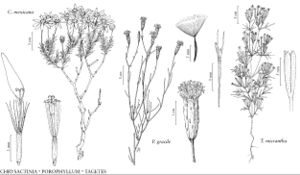Tagetes
Sp. Pl. 2: 887. 1753.
Gen. Pl. ed. 5, 378. 1754.
| Taxon | Illustrator ⠉ | |
|---|---|---|
 | Chrysactinia mexicana Porophyllum gracile Tagetes micrantha | Yevonn Wilson-Ramsey Linda Ann Vorobik Bee F. Gunn |
Annuals, perennials, subshrubs, or shrubs [perennials], mostly 10–80 (–200) cm. Stems erect, branched distally or ± throughout. Leaves cauline; mostly opposite (distal sometimes alternate); petiolate or sessile; blades mostly lanceolate to oblanceolate overall, usually 1–3-pinnately lobed or pinnatisect, ultimate margins toothed or entire, faces glabrous or hairy (oil-glands scattered and/or submarginal). Heads radiate or discoid, borne singly or in ± corymbiform arrays. Calyculi 0. Involucres narrowly cylindric or fusiform to turbinate or broadly campanulate, 1–12+ mm diam. Phyllaries persistent, 3–21+ in 1–2 series (connate to 7/8+ their lengths, usually streaked and/or dotted with oil-glands). Receptacles convex to conic, smooth or finely pitted, epaleate. Ray-florets 0 or 1–8 (–13+) (to 100+ in “double” cultivars), pistillate, fertile (except “double” cultivars); corollas yellow or orange, redbrown (with or without yellow/orange), or white. Disc-florets 6–120+, bisexual, fertile; corollas greenish yellow to orange, sometimes tipped with red or redbrown, tubes much longer than or about equaling funnelform throats, lobes 5, deltate to lance-linear (equal or 2 sinuses deeper than others). Cypselae narrowly obpyramidal or fusiform-terete, sometimes weakly flattened, glabrous or hairy; pappi persistent, of 2–5 (–10) dissimilar, distinct or connate scales in ± 1 series: 0–5+ oblong to lanceolate, erose-truncate or laciniate plus 0–2 (–5) longer, subulate to aristate. x = 12.
Distribution
Tropical and warm-temperate America, especially Mexico, in Old World
Discussion
Species 40+ (4 in the flora).
Some Tagetes species (e.g., T. erecta) produce nematicidal thiophenes in their roots and have been shown to be effective controls for nematodes in diverse crops (cf., http://www.ncagr.com/agronomi/nnote1.htm).
Reports of “Tagetes minima L.” for Pennsylvania (cf. http://plants.usda.gov) are evidently rooted in an error for T. minuta. Report of T. pusilla Kunth (= T. filifolia Lagasca) for Maryland (http://plants.usda.gov) was not verified for this treatment.
Selected References
Lower Taxa
Key
| 1 | Leaf lobes (or simple blades) linear to filiform, 10–25(–35+) × 0.5–1.5 mm | Tagetes micrantha |
| 1 | Leaf lobes lance-elliptic or lanceolate to lance-linear, 12–25(–50+) × (2–)4–8(–12+) mm | > 2 |
| 2 | Perennials, subshrubs, or shrubs | Tagetes lemmonii |
| 2 | Annuals | > 3 |
| 3 | Heads in ± corymbiform clusters; peduncles 1–5+ mm; involucres 7–10+ × 1.5–3 mm | Tagetes minuta |
| 3 | Heads borne ± singly; peduncles 30–100(–150+) mm; involucres 10–22 × (3–)5–12+ mm | Tagetes erecta |